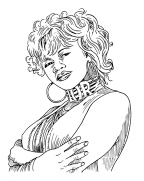In the early 1990s, when Lady Saw exploded onto the Jamaican music scene, she was best known for displaying in her songs and act a degree of raunchy “slackness” unmatched by any previous female artist. Since that time, she’s retained her dancehall crown by dint not merely of her outsize charisma and talent, but of the searching sensibility of an artist who’s scored Jamaican hits employing styles ranging from the tender twang of her country ballad “Give Me the Reason” to the exultant toasting of step-off anthems like “Chat to Mi Back.” The first female dancehall singer to headline shows outside Jamaica, she also entered North American pop consciousness via her hit-making appearance on No Doubt’s “Underneath It All,” the Orange County punkers’ 2002 smash that won her triple-platinum status and a Grammy for Best Record by a Duo or Group.
Born in 1972 to a large family in a small town in rural Jamaica, Marion Hall (as Lady Saw calls herself offstage) spent her girlhood racing wooden carts and learning to sing in church. In her teens she moved from her island’s countryside to its capital’s swelling slums, working for a time as a sweatshop seamstress before becoming Lady Saw and, as she puts it, “getting famous.” In addition to the hundreds of dancehall singles she’s authored or graced with a verse, she’s also released three full-length albums. All are marked, like their creators’ style of conversing, by a Prince-like affinity for veering joyously in tone from pious to lewd. This summer she will put out My Way, her ninth LP and her first to be released independently, on her own label, Divas Records.
On the warm December evening we were scheduled to meet in Kingston, our plan called for me to go see the Queen of the Dancehall at her home high in the hills over the city. Just before the appointed hour, though, she called to say she was hungry and to meet her at T.G.I. Friday’s instead. Arriving at the restaurant in a posh section of uptown Kingston, I found Marion and her sister settled into a corner booth, laughing and sipping their drinks, across the street from the fabled house where Bob Marley lived but never quite settled in the 1970s, writing songs about wanting to disturb his neighbors after riding his own musical success out of Kingston’s ghetto. While we ate and talked, Marion paused often to laugh and pose for snapshots with admirers. I had the Cajun chicken sandwich and two Red Stripes; Marion had a virgin strawberry daiquiri and the alfredo salmon pasta with a glass of white wine.
—Joshua Jelly-Schapiro
I. “THE GUYS WERE DOING IT, WHY COULDN’T A...
You have reached your article limit
Sign up for a digital subscription and continue reading all new issues, plus our entire archives, for just $1.50/month.
Already a subscriber? Sign in





